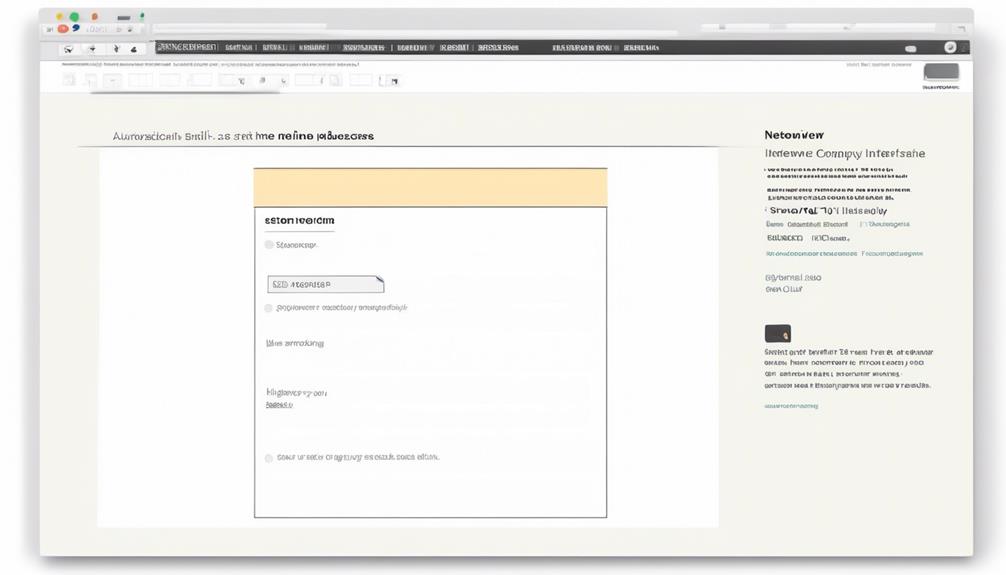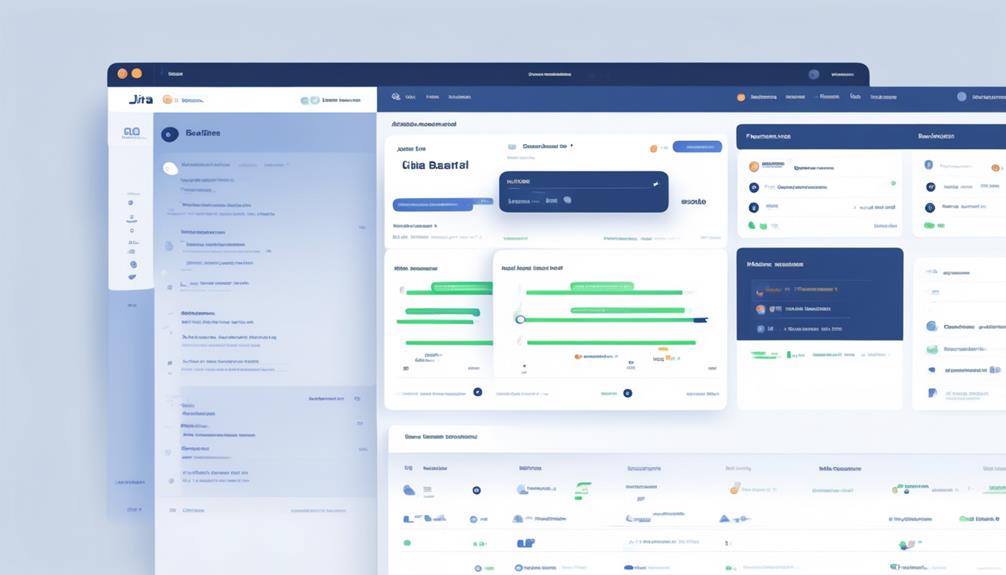It’s common for us to be managing time-intensive email duties while striving to keep up with our daily productivity.
Email automation in Python offers a solution to this challenge, streamlining the process of managing and sending emails.
However, while Python provides powerful automation capabilities, it's essential to consider the trade-offs in terms of visual customization and ease of setup.
As we explore the intricacies of email automation with Python, we'll uncover how this powerful language can revolutionize our email management practices and potentially revolutionize our workflows.
Key Takeaways
- Email automation in Python provides a streamlined and efficient method for sending out large volumes of emails.
- Personalized and targeted messaging in email automation enhances engagement and conversion rates.
- Python email automation allows for scheduling automated emails in advance for timely delivery.
- Incorporating multimedia and other content types into emails using Python's MIME modules adds value to email campaigns.
Email Automation Benefits
Email automation offers a streamlined and efficient method for sending out large volumes of emails, saving significant time and effort. By automating emails using Python, businesses and individuals can reap numerous benefits.
Firstly, automation allows for personalized and targeted messaging, enhancing engagement and conversion rates. With the ability to automate emails, it becomes easier to tailor content based on recipient behavior and preferences, leading to more meaningful interactions.
Additionally, automated emails can be scheduled in advance, ensuring timely delivery and reducing the chance of missed opportunities. This feature is particularly valuable for time-sensitive promotions or important notifications.
Moreover, organizing and managing email campaigns becomes more efficient with automation, enabling better tracking and analysis of email marketing efforts. Python email automation provides a simple and efficient way to automate email tasks, benefiting both individuals and businesses.
The utilization of Python for email automation empowers users to efficiently manage and streamline their email communication, ultimately leading to improved productivity and effectiveness in reaching their audience.
Setting Up Email Server Connection

To establish a connection with the email server, utilize the smtplib.SMTP class and specify the server and port. In Python, automating the sending of emails involves setting up the connection with the SMTP server.
After specifying the server and port, call the ehlo() method to identify the client to the server. Then, use the starttls() method to enable encryption using TLS for a secure connection. Once the connection is established, it's essential to authenticate with your email and password using the login() method to prevent information leakage.
Setting up the connection with the SMTP server is a crucial step in email automation. It allows you to securely connect to the server and authenticate before sending emails programmatically. This process ensures that your emails are sent reliably and with the necessary security measures in place.
In Python, automating the sending of emails requires a robust connection to the SMTP server. This setup enables the seamless transmission of emails and forms the foundation for efficient email automation. By understanding how to set up the connection with the SMTP server, you can ensure the successful implementation of automated email sending.
Adding Content Using MIME
Let's explore the basics of MIME for emails, including how to add HTML content and attach files to messages.
By leveraging Python's MIME modules, we can seamlessly incorporate multimedia and other types of content into our automated emails.
This approach allows for the creation of dynamic and engaging email communications, enhancing the overall effectiveness of our automated email tasks.
MIME Basics for Emails
Optionally using the MIMEMultipart module, we can create MIME documents representing a multipart message, supporting plain text and HTML languages.
The Python script to run an automated email can import MIMEMultipart to build the email structure.
We add plain text content using the MIMEText module and incorporate images by importing the MIMEImage module, defining the image file path, and attaching the binary data to the message as a MIMEImage part.
To include attachments, we use the MIMEApplication module, define the attachment file path, and attach the binary data to the message as a MIMEApplication part with the specified filename.
Additionally, we can customize email content by creating a CSV file with personalized information, replacing placeholders with actual values, and sending personalized emails to recipients.
HTML Content in Emails
Incorporating HTML content in emails using MIME allows for versatile formatting and seamless integration of images, building upon the foundation of supporting plain text and attachments.
To achieve this, we can use the MIMEMultipart module to create MIME documents representing a multipart message that supports plain text and HTML languages.
By importing the necessary modules such as MIMEText and MIMEImage, we can include HTML content and attach images to the email.
Additionally, the MIMEApplication module enables us to attach files to the email, expanding the range of content types that can be included.
With these capabilities, we can enhance the visual appeal and information delivery of the emails sent using Python, elevating the effectiveness of our email automation Python workflows.
Adding Attachments to Emails
To add attachments to emails using MIME, one can utilize the MIMEMultipart module to create MIME documents supporting various content types such as plain text, HTML, images, and files. By importing MIMEMultipart, we gain the ability to construct multi-part emails with attachments in Python. This allows us to send an email with added files, enhancing the communication and information sharing process.
Automation with Python enables the seamless handling of attachments, streamlining tasks and increasing efficiency. With the MIME modules like MIMEText, MIMEImage, and MIMEApplication, we can easily include plain text, images, and files as attachments to emails. This powerful capability enhances the functionality of email automation in Python, making it a valuable tool for various applications.
Sending Customized Emails

When personalizing emails, utilize the smtplib library to establish a connection with the email server and authenticate with your credentials. By creating MIME documents using modules like MIMEMultipart, MIMEText, and MIMEImage, you can add customized content and attachments to your emails. Python's email automation capabilities enable you to read data from a CSV file, replace placeholders with actual values, and send tailored messages to recipients. This can save time, improve workflow, and offer a simple and efficient way to send and receive emails. When setting up Gmail for Python automation, ensure 2-Step Verification is enabled and import necessary libraries to specify sender, receiver, subject, and body of the email.
To send customized emails in Python, the following steps can be taken:
| Step | Description |
|---|---|
| 1 | Import necessary libraries like smtplib, MIME, and csv. |
| 2 | Read data from a CSV file to personalize email content. |
| 3 | Use MIME modules to add customized content and attachments. |
Python Email Automation Setup

Let's talk about the essential aspects of setting up Python email automation.
We'll cover Python email libraries and how to set up the SMTP server for sending emails.
This will provide a solid foundation for automating email tasks using Python.
Python Email Libraries
How can Python's email libraries streamline the process of setting up email automation for efficient and personalized communication with recipients? Python's open source smtplib package enables users to send out emails using various services such as Gmail. MIME modules allow for the incorporation of diverse content types like plain text, HTML, images, and attachments in emails. Additionally, the ability to read a CSV file for personalized information and use placeholders makes it possible to customize email content. Python email automation also facilitates the scheduling of emails and setting up automated responses, saving time and effort, especially in email marketing campaigns. Moreover, SSL can be set up for secure email transmission, making Python email libraries an efficient choice for automating email tasks.
| Python Email Libraries | Features | Benefits |
|---|---|---|
| smtplib | Supports various services | Efficient email sending |
| MIME modules | Diverse content types | Customized email content |
| CSV file integration | Personalized information | Time-saving automation |
Setting Up SMTP Server
Python's email automation can be fully realized by setting up the SMTP server to enable seamless communication with recipients, leveraging the capabilities of Python's built-in smtplib package.
To set up the SMTP server for email automation in Python, follow these key steps:
- Use the smtplib.SMTP class to establish a secure connection with the server and port, ensuring the implementation of Transport Layer Security (TLS) for secure email transmission.
- Utilize the MIMEMultipart module to create MIME documents representing a multipart message, supporting various content types such as plain text, HTML, images, and file attachments.
- Customize email content by creating a CSV file with personalized information, replacing placeholders with actual values, and sending personalized emails to recipients.
Email Automation Best Practices

When implementing email automation best practices, it's essential to personalize the content to cater to the specific needs and interests of each recipient. Utilizing MIME modules allows for the inclusion of diverse content types, such as plain text, HTML, images, and attachments, in emails. Automating email sending involves customizing messages using data from CSV files and efficiently sending tailored emails to recipients. Python's smtplib and imaplib libraries can be employed to interact with email servers, automate tasks like scheduling emails, and handle incoming messages.
In addition, considering alternative email service providers like Mailmodo can offer a more user-friendly and visually appealing email automation setup, particularly for those seeking a no-code solution. It's crucial to prioritize the use of best practices when sending automated emails, ensuring that the content is relevant, engaging, and well-targeted. By adhering to these best practices, businesses can maximize the effectiveness of their email automation efforts, ultimately leading to greater engagement and conversions.
Alternative to Python Automation

Pivoting from our discussion on email automation best practices, exploring Mailmodo as an intuitive and cost-effective alternative for automated email campaigns offers a user-friendly solution with built-in analytics and pre-designed templates.
Mailmodo, as a user-friendly, no-code email service provider, presents an attractive alternative to Python automation for sending email messages. Here's why Mailmodo stands out:
- Pre-designed Templates: Access to 300+ pre-designed email templates streamlines the email creation process.
- Built-in Analytics: Detailed campaign insights provided by Mailmodo's built-in analytics facilitate effective monitoring and optimization of email campaigns.
- Visual Journey Builder: The visual journey builder allows for the creation of automated emails based on customer actions, enhancing the efficiency of email automation processes.
With these features, Mailmodo presents an affordable and efficient alternative to Python for email automation, making it an appealing option for businesses seeking to streamline their email marketing efforts without delving into the complexities of Simple Mail Transfer Protocol (SMTP) and Python automation.
Can I Implement Pipedrive Email Automation with Python?
Yes, you can implement Pipedrive email automation technology with Python. By using the Pipedrive API and Python’s programming capabilities, you can set up automated email workflows that streamline your sales process and enhance customer communication. Integrating these tools can help you improve efficiency and productivity.
Sending Email With Python

Sending emails with Python simplifies automating email marketing campaigns, streamlining the process and enhancing efficiency. When setting up emails using Python, the `smtplib` library is crucial for connecting to an email server and sending emails. The `MIMEMultipart` module allows the creation of MIME documents, supporting plain text and HTML languages, enhancing the customization of email content. In addition, by using a Python script to run monthly, you can automate the process of sending personalized emails to recipients, as well as handling attachments with ease using Python's email and MIME modules.
The table below demonstrates how Python simplifies the process of sending emails, making it an efficient and effective tool for email automation.
| Python Email Automation | Benefits | Emotion |
|---|---|---|
| Streamlined Process | Time-saving | Efficiency |
| Customized Content | Personalized interaction | Effectiveness |
| Automated Schedule | Stress reduction | Productivity |
Frequently Asked Questions
Can You Automate Emails With Python?
Yes, we can automate emails with Python.
We leverage Python's smtplib library to send emails and MIME modules to add various content types.
By reading personalized info from a CSV file, we send customized emails to recipients.
This automation boosts productivity and efficiency in email marketing.
While Python's system may have limited options for visually appealing emails, it offers a cost-effective and customizable alternative to third-party services.
How to Send Email Programmatically in Python?
Sending emails programmatically in Python is like crafting digital letters with code.
We use Python's smtplib library to connect to an email server and send messages.
With the MIME module, we can include various content types, such as text, HTML, images, and attachments.
By automating this process, we efficiently manage email tasks.
We consider system requirements, SSL support, and alternative service providers for a seamless email automation experience.
What Is the Easiest Way to Send Emails From Python?
The easiest way to send emails from Python is by using the built-in smtplib package. It supports various email services like Gmail and Yahoo, making it versatile for different providers.
Additionally, using the MIMEMultipart and MIMEText modules allows for adding different types of content to the email, such as plain text and HTML. This approach streamlines the process and allows for automation of email-sending tasks, saving time and effort.
How to Send Email Using API in Python?
We send emails using the Python API by utilizing the smtplib library to establish a connection with the SMTP server.
Then, we create a MIME message with the MIMEMultipart module, customize the content as needed, and send the email using the sendmail() method.
This approach provides flexibility and control over email automation, making it a powerful tool for various use cases.
Conclusion
In conclusion, diving into Python email automation is like unlocking a treasure trove of time-saving wonders.
With the power to schedule emails, personalize content, and set up automated responses, the possibilities are endless.
While Python email automation may have its limitations, the efficiency and convenience it offers are truly a game-changer.
So, don't hesitate to explore the world of Python email automation and witness the magic unfold in your email campaigns!









